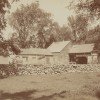Above: George Sawin examines a 1685 document “signed and sealed by the Indian Chiefs” who deeded land to his forefather. (images from SHS website)
The Southborough Historical Society’s cataloging effort has borne fruit again. This one is the discovery of 17th century documents centering around the Nipmuc tribe in our region.
Historical has announced:
partially based on this amazing find, we’ve applied for funding of a new traveling exhibit, “The Nipmuc, the English, and New England’s Forgotten War” which will debut at the museum in the fall of 2018 and then travel to local area schools and institutions.
According to the announcement, the papers include a 1656 document defining borders of a village of “Praying Indians” and a 1685 deal made between native americans and Thomas Sawin. While all of the land involved was in Natick, the Sawin family eventually became part of Southborough town history.
The post on Historical’s website overviews important history of conflicts between colonists and native tribes in the area. It then describes the context for the Sawin deal, including:
The diminished Nipmuc. . . invited Thomas Sawin, who had already set up a mill at Sherbourne, to come live among them and set up a mill. Their offer was 50 acres of land on the stipulation that he and his heirs and assigns were to maintain the mill forever, and that it was agreed that here was to be no other corn-mill built in town without the consent of Thomas Sawin, his heirs and assigns. Thomas Sawin kept his word, built the mill, and lived peaceably among the natives for the rest of his life, but even more importantly, he became an advocate for native rights with the Massachusetts General Court.
SHS explains that 148 years later the family was still running that mill. But, in 1833, Sawin’s descendant relocated to become a miller in our town after a clash of principals over slavery:
Moses Sawin became such an vocal abolitionist that when his fellow Natick church members tired of him and tossed him out, he picked up stakes and moved to Southborough.
 Sawin purchased the grist and saw-mill, among other properties. The documents were preserved and passed down within the family until the 1970s when the last descendents left. But, before they did, they donated the Sawin Family Documents to the Southborough Historical Society:
Sawin purchased the grist and saw-mill, among other properties. The documents were preserved and passed down within the family until the 1970s when the last descendents left. But, before they did, they donated the Sawin Family Documents to the Southborough Historical Society:
The various documents had by then been bound into an innocuous leather volume appropriately labeled Sawin Family Documents, but without any text or explanation. As such, it was dutifully placed on a basement storage shelf, and promptly forgotten. Then came the 2015 flood, and these priceless documents narrowly missed inundation. Returned to the Museum from temporary storage this spring, it wasn’t until we began the arduous process of unpacking and cataloguing the material did we discover the real value of what had been sitting on our shelves for 50 years. Today, the 13 documents have been carefully removed from their leather book ,which was showing signs of mold, rehoused in archival envelopes, and placed in our climate-controlled safe. . .
The importance of this find can’t be understated. The documents are of Smithsonian-level quality and importance, incredibly rare paper survivors from the earliest days of our nation. We are honored to be their conservators — which we can only do with your continued generous support.
For SHS’ full story, and images of the documents click here.


